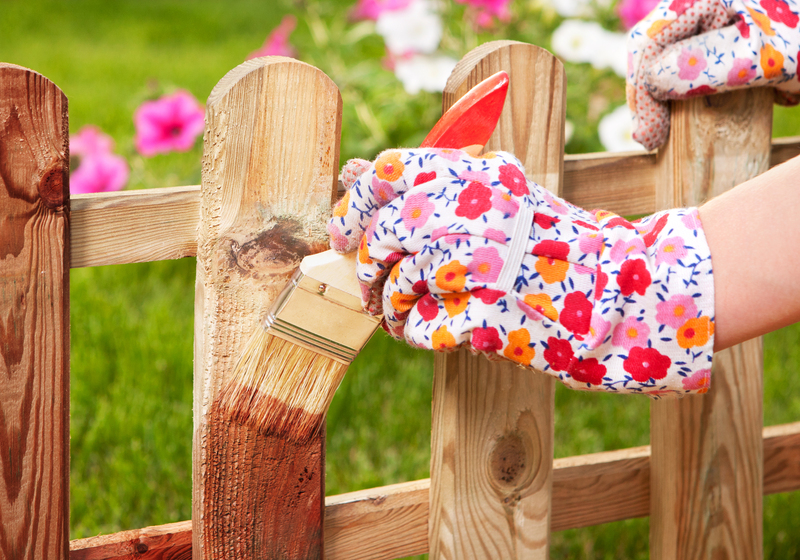Create a Colorful and Safe Garden Kids Will Love
Posted on 22/08/2025
Create a Colorful and Safe Garden Kids Will Love
Transforming your outdoor space into a colorful and safe garden for kids is both a rewarding and enjoyable project. A vibrant and child-friendly garden sparks creativity, encourages outdoor play, and fosters a connection with nature. With thoughtful planning and practical steps, you can craft a garden that delights the senses while ensuring safety for your little explorers. Whether you're starting from scratch or looking to upgrade your family's backyard, this comprehensive guide will help you create a playful, inspiring, and secure garden kids will absolutely love.
Why a Colorful and Safe Kids' Garden Matters
A child-friendly garden offers a world of benefits beyond its beauty. Studies show that children who spend time outdoors develop improved physical health, stronger problem-solving skills, and enhanced well-being. Planting a vibrant and secure garden for children nurtures curiosity and allows them to explore, learn, and play freely.
- Encourages Outdoor Activity: Nature-filled spaces inspire movement and creativity, helping reduce screen time.
- Stimulates the Senses: Bright flowers, fragrant herbs, and textured foliage offer sensory experiences that aid cognitive growth.
- Educational Opportunities: Kids can learn about science, ecosystems, and responsibility by caring for plants.
- Safe Play Environment: When designed well, gardens can provide a secure place for children to play with minimal risks.

Planning a Child-Friendly, Safe Garden
Assess Your Space and Sunlight
Before you start planting, observe your garden's sunlight patterns and available space. Note areas that receive morning, afternoon, or partial shade. This will help determine which colorful child-safe plants will thrive and where play spaces can be safely placed.
Set Clear Boundaries
Establish borders using low hedges, fences, or raised beds to define your garden zones. This step helps keep children in safe areas and out of less secure spots, such as garden sheds or compost piles. Natural boundaries like shrubs or decorative fencing add both color and safety.
Prioritize Safety Features
When designing a safe kids' garden, consider these features:
- Non-Toxic Plants: Avoid poisonous varieties and choose kid-safe flowers, fruit, and foliage.
- Soft Landing Surfaces: Use grass, mulch, or rubber mats under play zones to cushion falls.
- Secure Fencing: Prevent wandering with childproof gates and sturdy fencing around the perimeter.
- Tool Storage: Keep garden tools, chemicals, and fertilizers in locked areas out of children's reach.
- Clear Paths: Create smooth walkways free of tripping hazards for easy and safe navigation.
Choosing Colorful and Safe Plants for Children
The star of any colorful kids' garden is its plant palette. Select plants that are visually appealing, interesting to touch and smell, and--most importantly--non-toxic if curious hands explore them.
Top Kid-Friendly Plants
- Sunflowers: Towering stems and cheerful faces encourage planting competitions and pollinator visits.
- Marigolds: Their bright oranges and yellows delight the eye and help repel harmful insects.
- Nasturtiums: Edible flowers in lively shades, perfect for sensory exploration and salads.
- Snapdragons: Unique blooms that fascinate children and come in a spectrum of colors.
- Scented Herbs: Lavender, mint, lemon balm, and basil provide aromatic and curious hands with safe exploration.
- Strawberries: Easy-to-grow and delicious, strawberries let kids experience harvesting fruit firsthand.
Plants to Avoid in Children's Gardens
Steer clear of common garden plants that are toxic or have thorns, spines, or irritating sap. Some examples include:
- Oleander
- Foxglove
- Rhododendron
- Hydrangea
- Wisteria
- Daffodil bulbs
Always research any new plant before bringing it into your kids' safe play garden.
Infusing Vibrant Color: Design Ideas
Use a Rainbow Palette
Kids are drawn to bold, bright colors. Plan your beds and borders with a rainbow's diversity--think red poppies, yellow marigolds, blue cornflowers, and orange zinnias. Cluster groups of the same color for striking visual impact and easy plant identification.
Add Painted Garden Features
- Colorful Planters: Decorate pots with non-toxic paints; let kids customize their own!
- Garden Flags & Stones: Use weatherproof paints to make stepping stones or vibrant banners.
- DIY Garden Art: Hang wind chimes, mobiles, or recycled bottle art for extra whimsy.
Creative Structures for Play and Imagination
- Teepees and Tunnels: Construct living play spaces using bamboo poles and climbing vines like sweet peas or morning glories.
- Fairy and Dinosaur Gardens: Dedicate sections to themed miniature landscapes that inspire pretend play.
- Edible Mazes: Plant low hedges of culinary herbs for maze adventures that appeal to all senses.
Personalized structures make your family garden unique and deeply engaging for children.
Safety Tips for a Worry-Free Kids' Garden
Ensure Age-Appropriate Supervision
While the garden should be safe for solo play, younger children always need adult supervision. Be nearby during activities involving water, tools, or complex climbing features.
Prevent Water Hazards
- No Open Water: Avoid ponds or exposed barrels; use covered water features or shallow birdbaths only.
- Drainage: Ensure surfaces dry quickly after rain to minimize muddy slips.
Water play is fun, but always implement robust safety precautions.
Safe Materials and Surfaces
- Use Untreated Wood: For raised beds or play equipment, choose sanded, splinter-free timber.
- Rubber Matting or Mulch: Provides cushioning under swings or slides.
- No Sharp Edges: Inspect for broken pots, sharp stakes, or thorny branches often.
Allergy Awareness
Choose low-allergy plants like snapdragons, pansies, or camellias if children have pollen sensitivities. Keep an eye on bee-attracting blooms and educate children about gently viewing pollinators from a distance.
Engaging Kids in the Garden: Fun Activities
Give Children a Plot of Their Own
Dedicate a special patch or container for each child, letting them choose plants and designs. This fosters a sense of ownership and responsibility.
Start a Garden Journal
- Record Plant Growth: Use drawings or photos to track progress over weeks and months.
- Note Wildlife Visits: Spot butterflies, bees, or birds and create a logbook of discoveries.
Sensory and Imaginative Play
- Plant Touch and Smell Gardens: Include lamb's ear, mint, or rosemary for tactile and olfactory fun.
- Mud Kitchens & Fairy Houses: Build creative play spots using safe, natural materials.
Encourage creativity with loose parts like stones, shells, and sticks for endless imaginative play.
Low-Maintenance, Eco-Friendly Garden Practices
Sustainable Gardening for Families
- Compost Pile: Set up a small, contained compost bin to teach kids about recycling organic waste, making sure it's out of reach for little ones.
- Collect Rainwater: Use a rain barrel with a secure lid for eco-friendly watering.
- Mulch Beds: Conserve moisture and reduce weeds while delighting kids with fun textures.
Low-Maintenance Gardening Tips
- Choose Hardy Annuals and Perennials: Opt for plants that flourish with minimal care, such as marigolds and lavender.
- Automated Watering: Drip irrigation systems are safer and more efficient than garden hoses left lying around.
- Mulch Pathways: Mulched or bark chips make soft, safe walking areas that are easy to maintain.
Easy DIY Garden Projects for Kids
Painted Rocks
Gather smooth stones and let kids paint them as markers, animals, or magical characters--perfect for decorating garden beds.
Miniature Gardens
Plant a mini fairy or dinosaur world in large pots, using small-scale plants and toys for enchanting displays.
Wind Chimes and Mobiles
String together shells, beads, or old keys for upcycled garden music--hung safely out of reach, adding soothing sounds.

Maintaining Your Vibrant, Safe Kids' Garden
Seasonal Checklists
- Spring: Inspect fences, edge borders, reseed grass, and add fresh mulch.
- Summer: Water early to prevent slippery surfaces and monitor for pests (safely, without chemicals).
- Autumn: Harvest edible plants, tidy beds, and rake leaves for fun piles.
- Winter: Trim perennials, store play equipment, and plan new color schemes for the next season.
Regular Safety Audits
Walk your garden every month to check for:
- Broken equipment or sharp edges
- Toxic plants or mushrooms that may have seeded naturally
- Locked tool storage
- Gaps in fencing
Vigilance keeps your vibrant garden a safe haven for your children all year round.
Conclusion: A Colorful, Safe Haven for Childhood Memories
Creating a colorful and safe garden for kids is not just about aesthetics but about fostering joy, wonder, and well-being. With bright, safe plants, playful features, and practical safety measures, your family garden becomes a cherished outdoor classroom and playground. Get your children involved in every step--from choosing seeds to building fairy houses--and watch their confidence and love for nature blossom.
So, grab your trowels, gather the kids, and start designing a beautiful, child-safe garden bursting with color, imagination, and adventure--a place they'll treasure for years to come.

